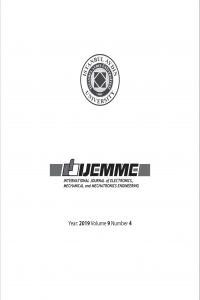Abstract
Today, mitigation of the adverse impacts of drought has gained considerable
importance in the context of the management of water resources, which is adversely affected by
climate change. In this context, to be able to achieve drought risk analyses, meteorological and
hydrological data should be sufficient; if they are not, they should be completed. Seyhan Basin
spread across the Seyhan River to an area of 2.203.544 ha, extending from Sivas to the Eastern
Mediterranean. With 22.035 km2, the basin area constitutes 2.07% of Turkey's surface area. In this
study, by using the meteorological and hydrological data of Seyhan basin between 1970 and 2016,
drought risk analyses of the basin with the most widely used around the world SPI, SRI and SPEI
drought indices were discussed. In first step of this study, incomplete data was completed with
regional analyses. According to these indices, drought severity and magnitude were found.
Analyses were performed according to 1, 3, 6, 9, 12, 18, 24, 48-month repeat intervals.
Classification of droughts and threshold values were determined. The indices were compared, the
correlation between them was examined, and drought risk analyses and drought maps were made
separately for each index.
Keywords
References
- [1] Yuksel, I. (2018). The South-Eastern Anatolia project factor on water management and energy demand in Turkey. Fresenius Environmental Bulletin. 27(1), 246-253.
- [2] Gulbaz, S., et al. (2017). A calibrated hydrological model for Alibeyköy watershed in İstanbul, Turkey incorporating lid implementation. FEB-Fresenius Environmental Bulletin, 6112.
- [3] Wilhite, D. (2000), Drought: A global assessment Hazards and disasters: A series of definitive major works. Routledge, New York.
- [4] UNDP (2016). Drought Risk Management. [5] Wilhite, D.A., Sivakumar, M.V., and Pulwarty, R. (2014). Managing drought risk in a changing climate: The role of national drought policy. Weather and Climate Extremes. 3, 4- 13.
- [6] Al-Safi, H.I.J. and Sarukkalige, P.R. (2017). Assessment of future climate change impacts on hydrological behavior of Richmond River Catchment. Water Science and Engineering. 10(3), 197-208.
- [7] EC (2007), Drought management plan report: including agricultural, drought indicators and climate change aspects European Commission Directorate of Environment. [8] Svoboda, M. and Fuchs, B. (2016). Handbook of Drought Indicators and Indices.
- [9] McKee, T.B., Doesken, N.J., and Kleist, J. (1993). The relationship of drought frequency and duration to time scales. in Proceedings of the 8th Conference on Applied Climatology. American Meteorological Society Boston, MA.
- [10] WMO (2012). Statement on the Status of the Global Climate in 2012. Geneva, Switzerland: World Meteorological Organization.
- [11] Zargar, A., et al. (2011). A review of drought indices. Environmental Reviews. 19(NA), 333- 349.
- [12] Lloyd‐Hughes, B. and Saunders, M.A. (2002). A drought climatology for Europe. International journal of climatology. 22(13), 1571-1592.
- [13] Vicente-Serrano, S.M., Beguería, S., and López-Moreno, J.I. (2010). A multiscalar drought index sensitive to global warming: the standardized precipitation evapotranspiration index. Journal of climate. 23(7), 1696-1718.
- [14] Van Loon, A.F. (2015). Hydrological drought explained. Wiley Interdisciplinary Reviews: Water. 2(4), 359-392.
- [15] Thornthwaite, C.W. (1948). An approach toward a rational classification of climate. Geographical review. 38(1), 55-94.
- [16] Sheffield, J. and Wood, E.F. (2008). Projected changes in drought occurrence under future global warming from multi-model, multi-scenario, IPCC AR4 simulations. Climate dynamics. 31(1), 79-105.
Details
| Primary Language | English |
|---|---|
| Subjects | Engineering |
| Journal Section | Articles |
| Authors | |
| Publication Date | October 1, 2019 |
| Published in Issue | Year 2019 Volume: 9 Issue: 4 |


